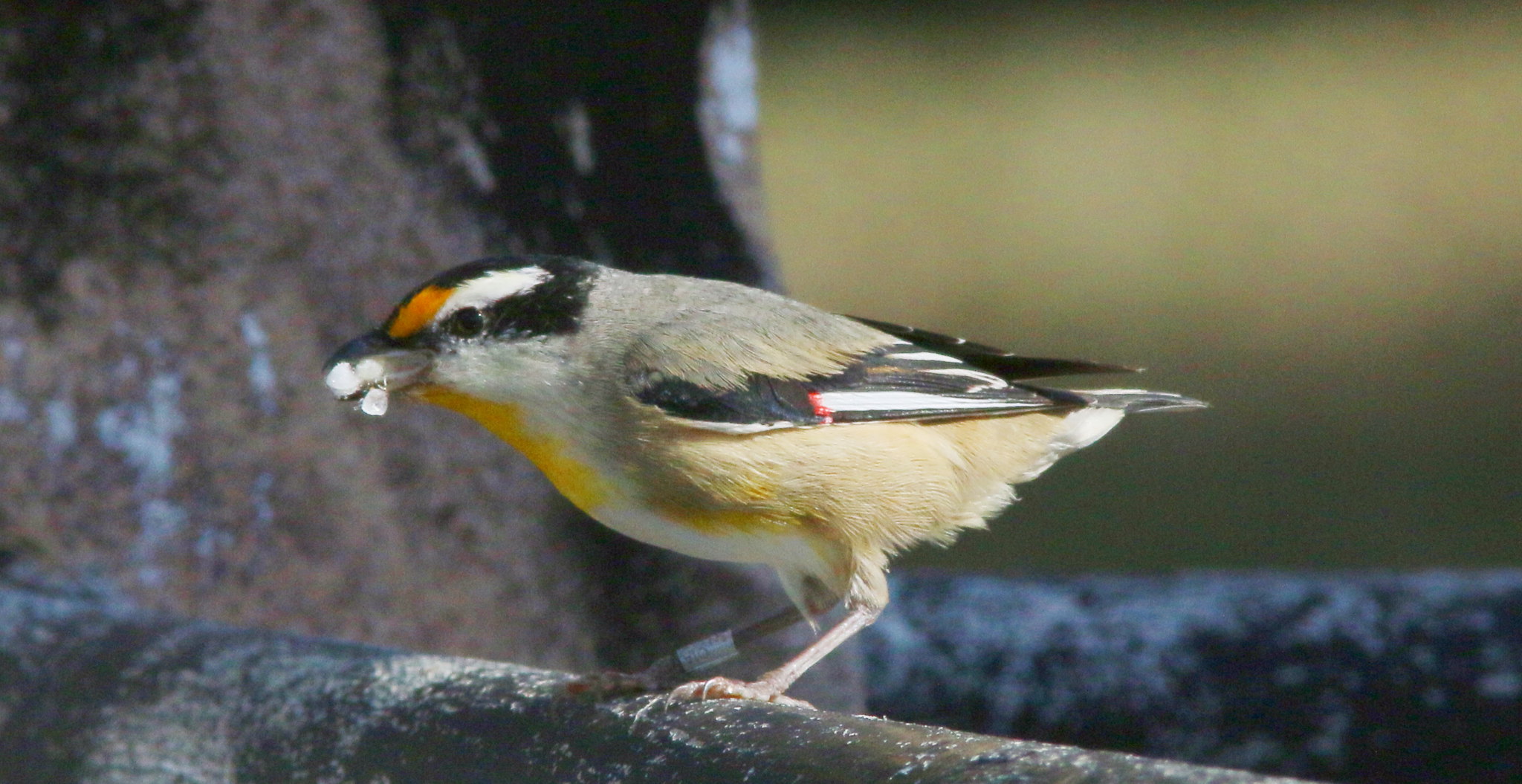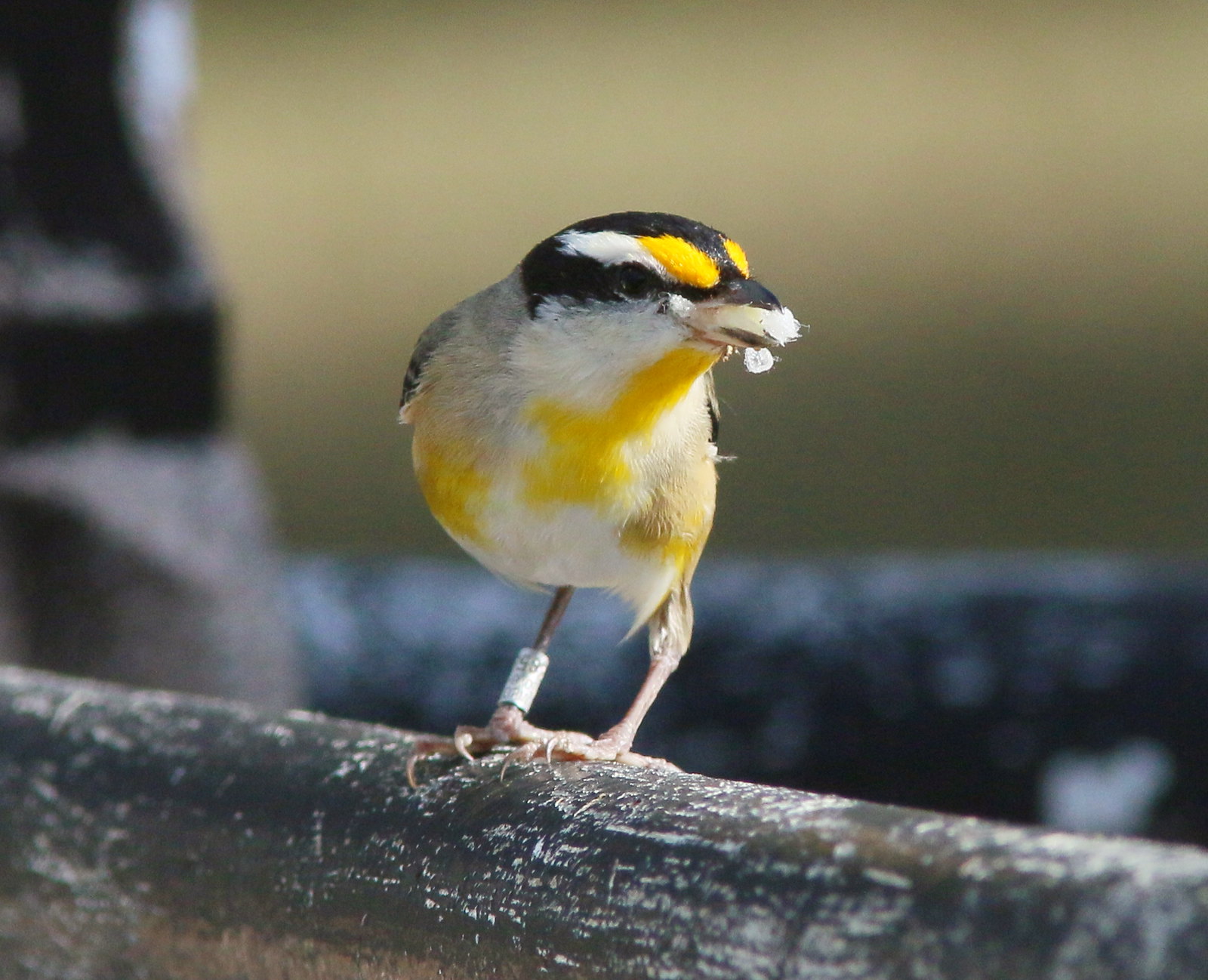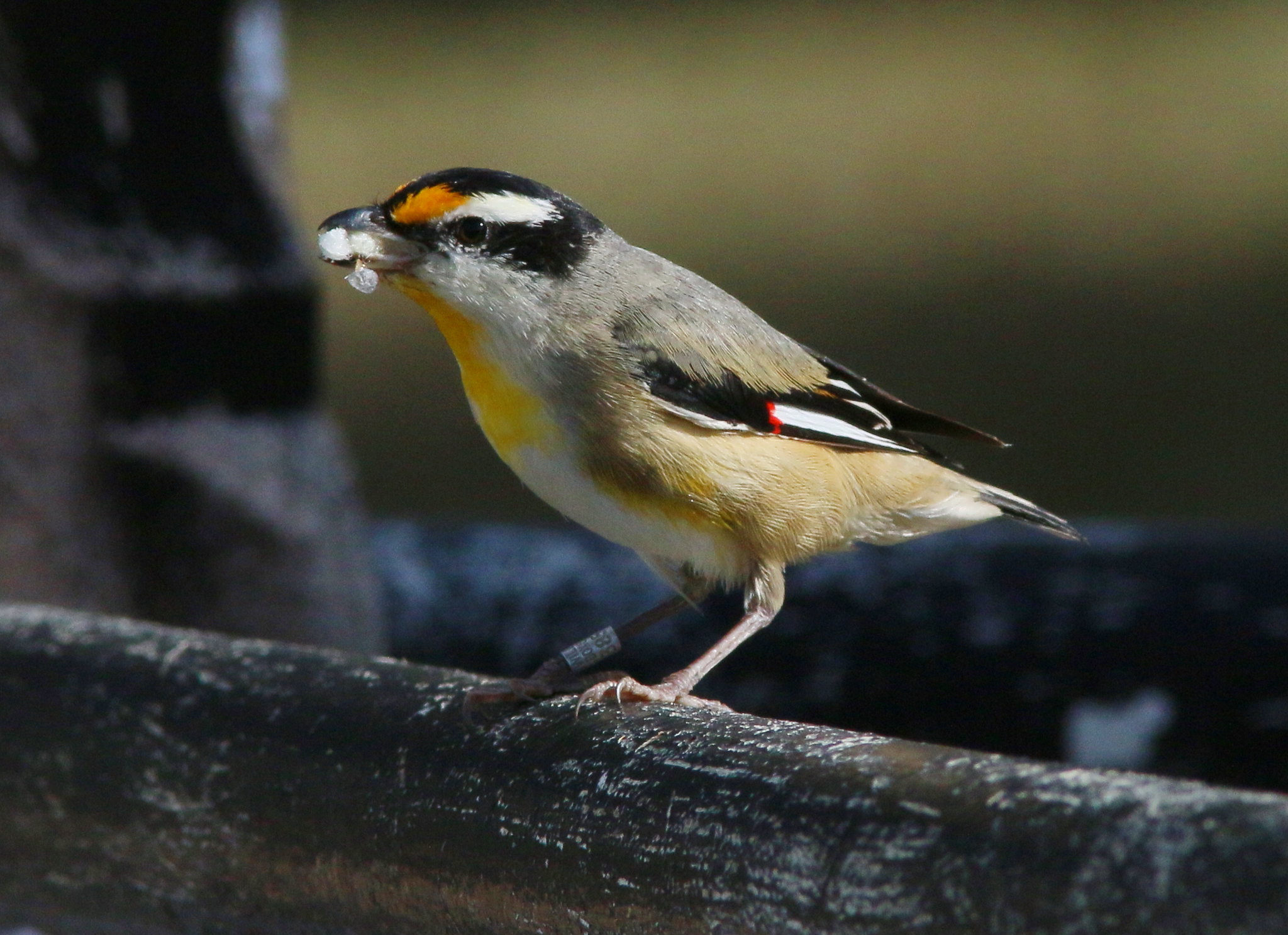who pointed out to me a small hole about 25mm in diameter which was the opening to a Striated Pardalote's nest.
I was even more surprised when I downloaded the photographs to find that the bird had a small ring on one leg.
The birds seemed to be returning with what looked like spiders eggs? I'm sure someone will be able to confirm what is they were carrying.
















Magic photos Reflex!
They look a little like flying ants eggs. I'm sure someone more scientific can help :-)
Beautiful photos
M-L
Top set in what looks like challenging light.
Cheers
Cage
Hunter Valley NSW
I was as close to the nest hole as I could be with 300mm (about 3 metres).The parents were not comfortable with me being that close but I can almost understand the logic..God he's big..I reckon he's watching us!..Why is he pointing something at us? Who cares I'm in to that hole so quick he can't do anything about it..
Samford Valley Qld.
Very cute little bird, lovely colours and markings. Great photos!
It's that one big 'eye' they find disturbing.
Cheers
Cage
Hunter Valley NSW
I think those small white balls are the coverings of psyllids, an insect that feeds on Eucalyptus leaves. Flocks of Striated Pardalotes can sometimes be heard in a Eucalyptus canopy snipping & nipping off the waxy coating containing the psyllids. If I remember rightly the covering is sugary or waxy or both. I suspect the bird in the photo is feeding the coverings, probably containing the psyllids, to its young. In areas where old Eucalypts with hollows have been destroyed/wrecked/vandalised psyllid populations can explode because there are no predatory Pardalotes. Hence the Eucalypt foliage looks almost dead. This is a form of Eucalyptus dieback.
So, if you're loath to have your local Eucalypts looking languid then stop the euthanising of your old Eucalypts.
Thanks Woko.
Samford Valley Qld.
Those photos are so good that with a few more shots you would have been able to read the whole ring ID. I'll bet the "ringers" would have been glad to get a report on the bird while it was still alive.
Actually I wondered about that yesterday Night Parrot.
Is there anyone who would want this information? Not that I can see all the numbers but I could have another look and I'm planning to go back this week-end to see if I can get some better shots of the Figbird.
Samford Valley Qld.
You'd think someone in Birdlife Australia might be able to come up with some suggestions. There can't be that many wildlife projects involving the banding of pardalotes. Maybe a university?
Outstanding Reflex! Thankyou to the lovely Julie indeed, these are wonderful shots indeed. I think Woko is spot on, they look like psyllid covers. I've seen some wonderful photographs of them, unfortunately I've never been able to locate any myself, very interesting structure in a macro shot anyway. They could also be the sugary exudates some plants produce during pollination (I think), similar to psyllid covers, they like those also. Sorry I can't explain that a little better, Mr Google might help there, I can barely remember how to spell exudates . These little guys are seasonal visitors for Tas and all last summer I could hear them in the canopy but was never fortunate to see one closer than from 30 metres below. Thanks for sharing!
. These little guys are seasonal visitors for Tas and all last summer I could hear them in the canopy but was never fortunate to see one closer than from 30 metres below. Thanks for sharing!
West Coast Tasmania
Thanks Annie. Considering I only saw my first Pardalote a few months ago I was pretty pleased with this encounter. I've also realised that of all the photographs I took of them, I've only showed the same bird on here. At one stage I had both parents on the rail deciding whether to go into the nest or not whilst I was watching them.
It's almost unbelievable to think of these tiny things flying across Bass Strait although I've discovered that they are not the only small bird that does this. The Silvereye is another one. Tiny birds no more than 10 centimetres long and weighing less that 10 grams making an annual 1,600 kilometre trek from Tasmania, across Bass Strait, and as far north as Queensland. It's the equivalent of a human swimming from Auckland to Sydney, then walking to Cairo. Why they make this treacherous journey in the first place is another question entirely. Why risk travelling back across Bass Strait in spring when there's plenty of food available on the mainland?
Samford Valley Qld.
They're incredible aren't they! This is an interesting short article I think I posted a long time ago, somewhere, about Silvereyes migrating.
http://www.abc.net.au/science/articles/2001/05/01/2616451.htm
Definitely some stay in Tas over winter as the article mentions, although very very few. I wonder if perhaps the ones that stay are older or not 100% health-wise, so choose not to leave. Or is it just that they miss the boat so to speak or don't want to for whatever other reason? Who knows, all extremely interesting either way.
Regardless of the island hopping type migration they're thought to do, I can't imagine the pummelling winds they must endure (or any migrating bird for that matter) when they cross over The Strait. As far as them travelling back, as it's only the Tas subspecies of Silvereye who do this annual trip, perhaps there is just no place like home, pure instinct draws them back here? Who will ever know. I've also often wondered, do they mingle with the other subspecies of Silvereye while on the mainland, or keep within their own groups? Do any other subspecies "accidentally" come back with the large flocks. Don't know, haven't been able to find out - so many questions Had our first huge flock of them fly over our house only days ago making a delightful racket. One of many recent signs that Spring is around the corner! Yay! I love all seasons but have to admit I think this Winter has been one of the coldest, wettest and windiest ones I've experienced since moving to Tas, so looking forward to a seasonal change!
Had our first huge flock of them fly over our house only days ago making a delightful racket. One of many recent signs that Spring is around the corner! Yay! I love all seasons but have to admit I think this Winter has been one of the coldest, wettest and windiest ones I've experienced since moving to Tas, so looking forward to a seasonal change!
West Coast Tasmania
Couldn't help myself, I went back to the same spot to-day and there was two birds flitting about the nest hole.
I'm not sure if it was the mother and a chick or two chicks. Young birds are less prone to being afraid of humans but the maternal instinct kicks in when a mother senses danger so I'm not sure who was who to-day. Getting closer to that "AnnieJ"clarity....
Getting closer to that "AnnieJ"clarity....
Samford Valley Qld.
Wonderful again .... fantastic little birds.
That first one is a beauty, very sharp.
You really are a constant sourse of inspiration WD. I thought about you to-day even though the photographs were terrible.
Have you ever seen a Eastern Whipbird?
I did to-day. They are determined not to have their photograph taken.
Samford Valley Qld.
Yes those whipbirds are more often heard than seen, and when seen they are often hidden away in the undergrowth or foliage. I have not got a good photo of one yet.
Another bird with a band on the week-end from the same spot.
Samford Valley Qld.